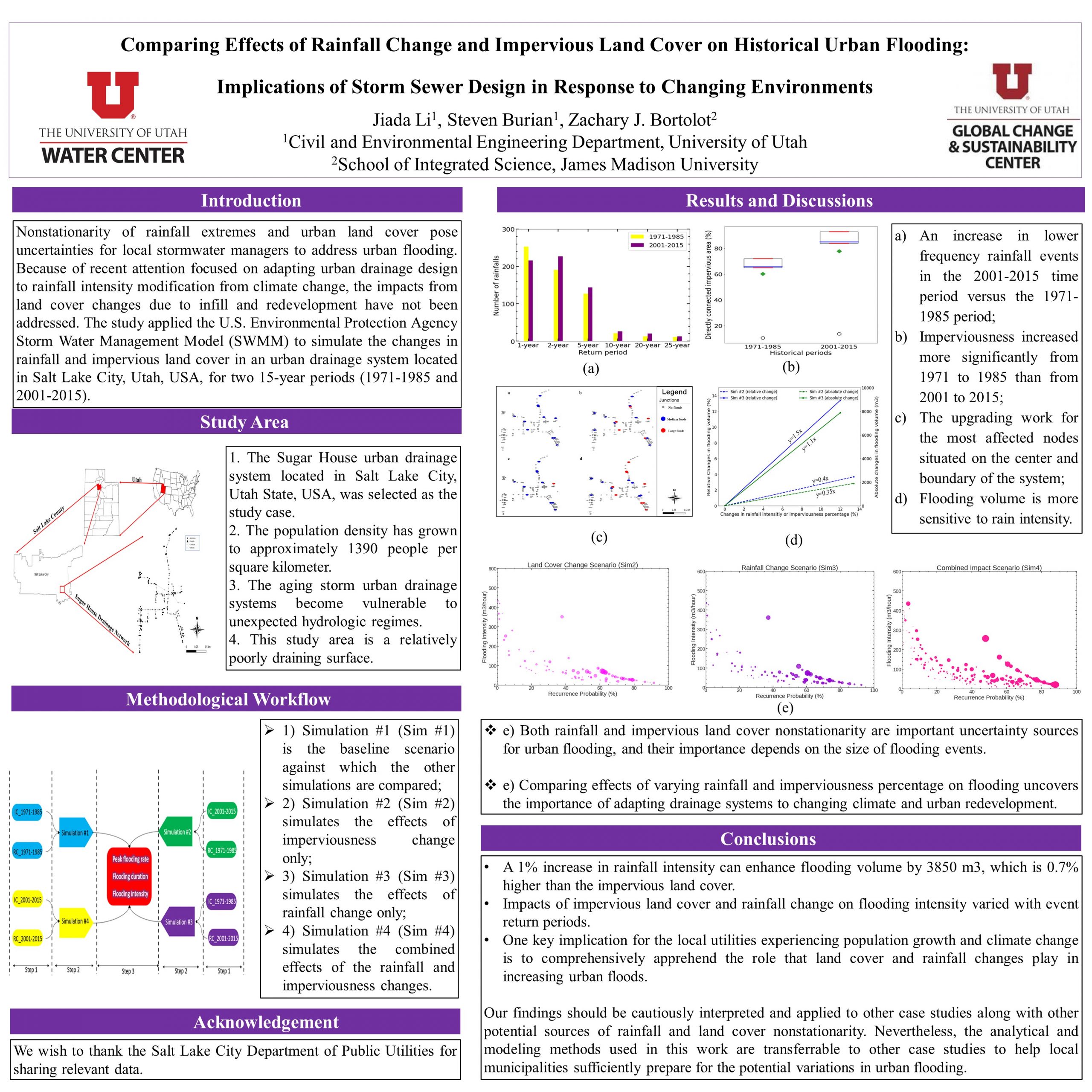Quantifying the impacts of rainfall and land cover change on urban flooding
-Jiada Li
[bs_collapse id=”collapse_3de4-3076″]
[bs_citem title=”Bio” id=”citem_6857-8f74″ parent=”collapse_3de4-3076″]
Jiada completed his bachelor’s degree at South China University of Technology and master’s degree at Tongji University in the Department of Municipal Engineering. He is currently working as a graduate research assistant in Urban Water Group of the Department of Civil and Environmental Engineering at the University of Utah. Jiada’s current research aims to address the research needs, respectively by i) quantifying the observed effects of changes in rainfall intensity and catchment percent imperviousness on drainage system flooding; ii) examining the potential effects of future changes in rainfall and land cover on urban drainage flooding; and iii) investigate the tradeoff of resilience and cost for retrofitting a stormwater system with green infrastructure, real-time control, traditional passive control, and storage tank addition to prevent urban drainage flooding from projected rainfall and surface landscape changes.
[/bs_citem]
[bs_citem title=”Abstract” id=”citem_0bc0-45e9″ parent=”collapse_3de4-3076″]
This paper quantitatively compares the impacts of individual and combined precipitation-imperviousness changes on the spatiotemporal increases in urban flooding in a real-world urban drainage system in Salt Lake City, Utah, USA. Urban flooding forced by precipitation-imperviousness changes is simulated for two historical 15-year periods corresponding to past (1971-1985) and recent (2001-2015) timelines. In all, four long-term continuous simulations are made. It is generally observed that growth in impervious surfaces and precipitation intensity, both together and alone, is set to elevate the runoff peaks, flooding volume, duration, and event intensity with varying influential extents. Particularly, effects comparing results show that climatic changes are more sensitive to flooding volume and duration, and consequently trigger larger flooding volume and duration, while imperviousness variations induce greater impacts on the peak runoff rate and event-level flooding intensity.
[/bs_citem]
[bs_citem title=”Narrative” id=”citem_f2c3-8d0f” parent=”collapse_3de4-3076″]
Cities addressing urban flooding issues must consider several uncertainties, including climate change, aging infrastructure, and changes in urban landscape surfaces. A better understanding of underlying drivers for urban flooding is critical for minimizing the adverse impacts of uncertain changes. However, with substantial attention being directed to climate adaptation, potentially significant influences from urban landscape changes, and the need to consider both urban land cover and climate changes in urban drainage planning and design remains an area for study. This paper quantitatively compares the impacts of individual and combined rainfall-imperviousness changes on the temporospatial increases in urban flooding in a real-world urban drainage system in Salt Lake City, Utah, USA. Urban flooding forced by rainfall and impervious surface changes is simulated for two historical 15-year periods, 1971-1985 and 2001-2015. In all, four long-term continuous simulations are made. Results show that climate change and urbanization, both combined and individual, aggravate urban floods. Climate change is more sensitive to the flooding volume and induces greater impacts on the peak runoff rate and flooding duration. A flooding intensity correlation analysis reveals that changes in flooding extremes significantly depend on impervious land surfaces than rainfall intensity changes. Influenced by the combined changes in land surface imperviousness and rainfall, the number of highly-flooded nodes have doubled over these two periods. These findings stress the importance of learning from the historical climate-urbanization uncertainty that enables the stormwater urban drainage design to adapt to changing environments, and also to help practitioners and decision-makers to prioritize flooding mitigation measures.
[/bs_citem]
[/bs_collapse]

